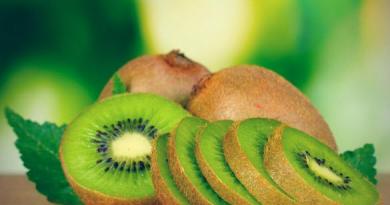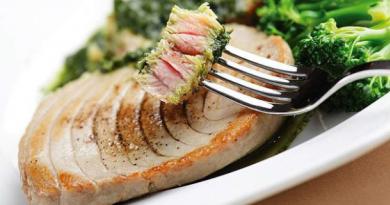Horseradish is known to us as a burning spicy vegetable, which is used in food as a seasoning that gives the dish a sharpness and piquancy. But its application does not end there. The root crop has an extensive vitamin and mineral composition. The abundance of useful properties allows you to use it not only for culinary, but also for medicinal purposes. Doctors recommend adding horseradish to food with excess weight, sciatica, inflammation and a number of other diseases.
Alternative medicine is replete with various recipes using this plant. Horseradish is an excellent prophylactic against a number of diseases. About what properties the root crop has, and how to use it correctly for health benefits, we will consider further.
Natural composition
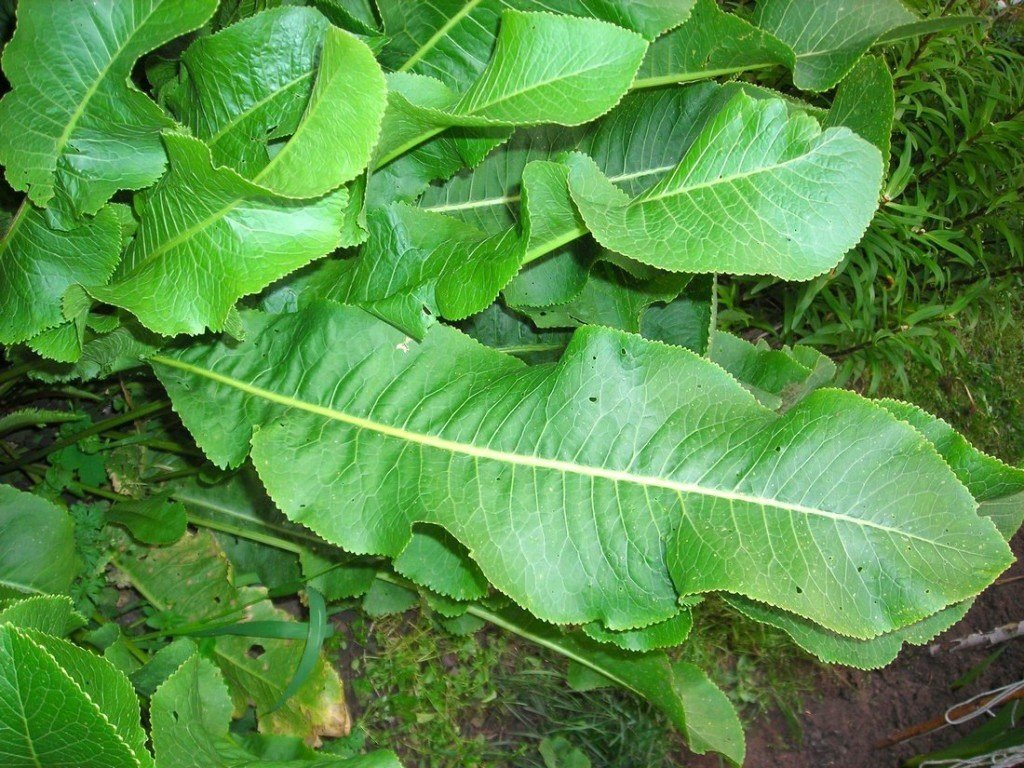
The beneficial properties of horseradish are due to the rich natural composition. Not only the roots of the plant, but also its leaves are of particular value. The abundance of vitamins and minerals contained in horseradish allow it to be used in various fields.
The chemical composition of this plant is represented by:
- Vitamins - A, E, C, B1, B2, B6, B9, PP;
- macro- and microelements - potassium (579 mg.), calcium (119 mg.), magnesium (36 mg.), sodium (100 mg.), phosphorus (130 mg.) and iron (2 mg.);
- antioxidants;
- ascorbic acid (horseradish roots and leaves contain 4-5 times more of this substance than citrus fruits);
- beta-carotene and niacin;
- amino acids;
- mono-disaccharides;
- starch;
- resinous substances;
- fiber;
- alkaloids;
- antibacterial chemical compounds;
- essential oils, etc.
Of the essential oils, it is worth noting mustard oil, which determines the taste and smell of this vegetable. In small quantities, it is good for health, helps fight colds and strengthens the immune system.
Despite the abundance of useful components, horseradish is different low calorie- only 56 kilocalories per 100 grams of product. Nutritional value is represented by: proteins - 3.2 g, fats - 0.4 g and carbohydrates - 10.5 g.
Useful properties for women and men

In alternative medicine, horseradish is used quite often. The plant has a stimulating, antiseptic, anti-inflammatory, expectorant, choleretic, antiscorbutic and antihelminthic effect.
Horseradish for medicinal purposes is prescribed for colds, gastrointestinal diseases, various inflammatory processes, as well as rheumatism, diseases of the liver, bladder, and even skin diseases. In the old days, sciatica was treated with horseradish. It was crushed to the state of gruel and then applied to the sore spot in the form of a mustard plaster.
The plant is recommended to be eaten as a prevention of acute respiratory diseases. During colds, it is useful to make poultices, applying them to the feet and legs. Horseradish is especially useful for treating coughs and sore throats. The plant has an expectorant effect, stimulating the production of sputum from the bronchi.
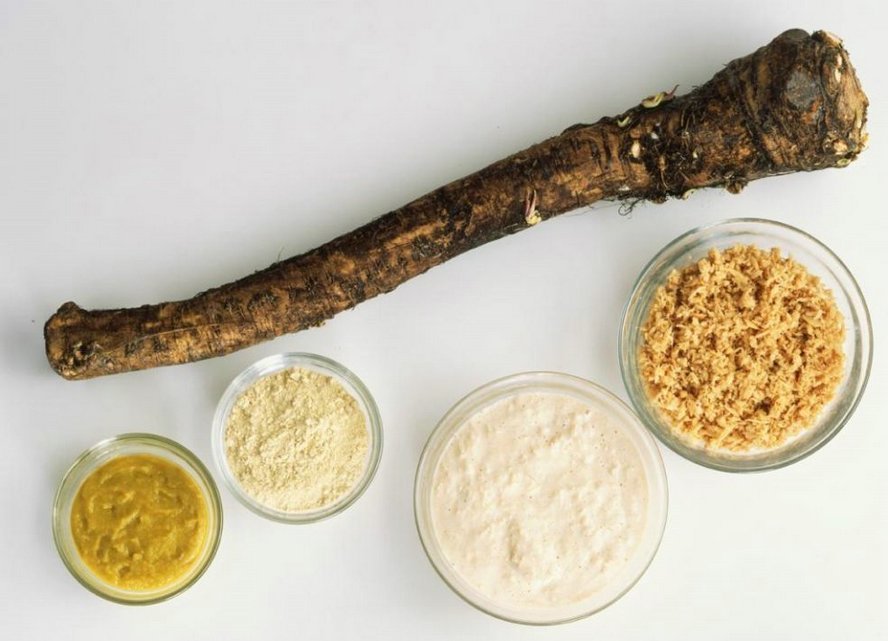
Useful and effective traditional medicine recipes:
Treatment of sciatica
A fresh horseradish root is taken and rubbed on a fine grater. The resulting mass is mixed with high-fat sour cream in proportions of 2 to 1 and applied to the sore spot. The applied compress is kept for 30-40 minutes, then removed. The procedure is repeated 2-3 times during the day, with breaks of 3-4 hours. The full course of treatment takes three weeks.
high cholesterol
To lower the level of cholesterol in the blood, you need to take 100 g of chopped horseradish root, a whole unpeeled lemon and 100 g of peeled garlic. The ingredients are passed through a meat grinder or manually processed on a grater. The resulting mass is diluted with boiled water in a ratio of 1 to 1 and placed in a cold, protected place for a day. The infused mixture should be stored in the refrigerator and taken in the morning and evening, 30-40 minutes before meals. One serving - 1 tbsp. l. with top. To improve the taste, it is recommended to add 1 tbsp to the mixture. l. bee honey.
Cirrhosis of the liver
Fresh leaves of the plant are used to restore the liver. A remedy is prepared using nettle, horseradish and bee honey. 300-400 g of plant leaves are taken and ground into a homogeneous mass. All the juice is squeezed out of the resulting mass and mixed with honey in a ratio of 1 to 1. The mixture is stored in the refrigerator, in a sealed container. It is necessary to use it half a cup 4-5 times a day. The course of admission is 1 month.
Disorders in the digestive system
With disorders of the stomach and intestines, horseradish is useful in any form. The only exception in which horseradish will not be beneficial is stomach ulcers. For 200 g of chopped horseradish root, 3 cups of boiled water are taken. The components are thoroughly mixed and infused in a sealed container for 48 hours. Insist should be in a dark, cool, dark place. The resulting mixture is filtered and stored in the refrigerator, in a sealed container. One serving is divided into 4-5 parts and taken throughout the day, at regular intervals. The course of treatment is 5-7 days. Then there is a short break for 2 weeks. If necessary, the course is repeated.
High blood pressure
With increased pressure and diseases of the cardiovascular system, a remedy based on horseradish tincture will be useful. The root of the plant is finely chopped on a grater and poured with high-quality vodka or diluted medical alcohol. For 200-300 g of root, 0.5 liters of an alcohol solution or vodka are taken. Infused for 7-10 days, in a dark, cool place. Honey, pomace from beets, carrots, radishes and lemons are added to the finished tincture. All components are taken in equal proportions. The resulting mixture is poured into a closed container and stored in the refrigerator. It is necessary to take the medicine 3 times a day for 1.5 tbsp. l., 40-60 minutes before meals. The course of admission is 2 months. If necessary, the course of treatment is repeated after a monthly break.
Swelling of the legs
To prepare the product, 150 g of horseradish root, 50 g of lemon with peel and 1-2 tbsp. l. bee honey. Horseradish with lemon is passed through a meat grinder and thoroughly mixed with honey. The resulting mass is stored in the refrigerator. The product is intended for oral administration. It must be taken twice a day, immediately after meals. The full course of admission takes 18-20 days.
Inflammation of the genitourinary system
With cystitis and other similar diseases, infusion on horseradish roots helps. The root is finely chopped on a grater and poured with boiling water. For 1.5 cups of boiling water, you need to take 40 g of horseradish. You need to insist it for 10 minutes, then strain after cooling. The resulting infusion is divided into 4 equal parts and drunk throughout the day, every 2-3 hours. The full course of admission takes 2 weeks. If necessary, the treatment is repeated after a week break.
Stones in the liver and kidneys
For 200-250 g of horseradish rhizomes, 1 liter of high-fat milk is taken. The root is finely chopped and poured with cold milk. After that, the mixture is heated over low heat. Milk should not boil - before boiling, the mixture must be removed from heat. The resulting drink should be cooled and carefully filtered. Store in refrigerator, warm to room temperature before use. Drink 3 times a day before meals. The course of treatment is 1 month.
Runny nose
Treatment is carried out with the help of ethereal vapors of grated horseradish root. The root is ground into a gruel, closed in a glass bowl and aged in it for half an hour. The vapors are then inhaled through the mouth, in deep breaths, until all the ether has evaporated. For one time, you need 1 tsp. ground root. Repeat 4-5 times a day. The full course of treatment takes 5-7 days.
Angina
To combat sore throat, a diluted pomace of grated horseradish root is used. The rhizomes are carefully ground and squeezed into a glass container. For half a glass of juice, 0.4 liters of boiled water is taken. Water should be at room temperature. Angina is treated by gargling every 1-2 hours. The effect will be noticeable after 2-3 days. It is necessary to continue rinsing until complete recovery. The mixture is stored in the refrigerator, but before use it must be heated to room temperature.
The second recipe is based on horseradish leaves. For treatment, a decoction is prepared from the stems and leaves. For 200 g of chopped horseradish, 0.5 l of water is taken and heated over low heat. 5 minutes after boiling, the broth can be removed. The mixture is cooled and filtered through cheesecloth. Gargle every 1-2 hours. Only fresh green mass of the plant is suitable for use.
Inflammation of the gums and caries
For rinsing, an infusion on horseradish leaves is used. To prepare, you need 50 g of leaves per glass of water. Chopped raw materials are poured with boiling water and cooled. After that, it must be kept in the refrigerator for 5-7 days. The resulting mixture is filtered and then stored in the refrigerator. When used, the infusion is heated to room temperature. Used to rinse the mouth for 5-7 minutes, 3 times a day. It is necessary to use this folk remedy until a complete cure.
Osteochondrosis
For osteochondrosis of the thoracic or cervical region, whole leaves of the plant are used. The greens are scalded with water brought to a boil and applied warm to the affected area. From above, the compress is covered with cellophane and wrapped with a thick cloth or scarf. The compress is done in the evening and is not removed until the morning. Helps in the early stages of the disease.
The second method of treatment is baths from dried leaves. It is advisable to collect young horseradish leaves. The collected raw materials are dried and stored in a dry and cool place, in a closed package. Dried greens are immersed in boiling water and aged in a closed container for 24 hours. For 0.5 kg of raw materials, 3 liters of water are taken. The resulting infusion is filtered and poured into a bath of warm water. For treatment, it is enough to take a bath for 25-30 minutes, once a day for a month.
Headache
Green horseradish leaves help with headaches. With pressure drops and other external causes, it is recommended to make a compress from the frayed green mass of this plant. The leaf is finely chopped and ground into a pulp. The resulting mass is wrapped in a bandage or gauze bandage and applied to the temples. The tool helps 15-20 minutes after application. It also helps with otitis externa and inflammation of the gums.
Sinusitis and purulent tonsillitis
With advanced purulent inflammation of the nasopharynx, horseradish-based honey tincture helps. A three-liter glass jar is filled almost to the top with crushed leaves and filled with warm water. Then 3 tbsp is added to the mixture. l. honey and half a glass of lemon juice. The tincture is thoroughly mixed, cooled and placed in the refrigerator for 5-7 days. After insisting, the mixture must be shaken and carefully filtered. Accepted for 1 tbsp. l. 30-40 minutes before meals, 3 times a day. The full course of admission is 2-3 months, then a monthly break is made.
Cleansing the body of salts and toxins
To cleanse the body after illness and poisoning, vodka tincture on horseradish leaves is used. For 200-300 g of chopped leaves, 0.5 liters of high-quality vodka is taken. Vodka can be replaced with a 40% solution of medical alcohol. The mixture is infused for at least one and a half weeks, in a dark and cool place. The tincture is carefully filtered before use. It must be stored in the refrigerator. Take 1 tbsp. l. half an hour before meals, 3 times a day. The full course of treatment takes no more than 2-3 weeks.
For weight loss and metabolic disorders
For problems with excess weight or metabolic disorders, you can use the roots and leaves of horseradish. It is advisable to take greens, it has fewer calories and its action is more effective. Greens are ground into gruel and consumed before meals. It is not recommended to use horseradish for gastritis and inflammation of the mucous membranes of the digestive tract. To get rid of excess weight, it is enough to eat 1 tbsp. l. before meals 3 times a day.
Those wishing to lose weight are also recommended freshly squeezed horseradish juice. The leaves are ground with a meat grinder and carefully squeezed out. It is necessary to consume one third of a glass 3 times a day 30-40 minutes before meals. Full course of admission - 2 months. If necessary, the course is repeated after a monthly break.
In cooking
The main use of horseradish is as a seasoning and for preserving food. Fresh horseradish leaves are added to pickles and marinades. Horseradish leaf powder is used as a spicy seasoning.
But there are several recipes in which horseradish is one of the main ingredients.
horseradish seasoning recipe
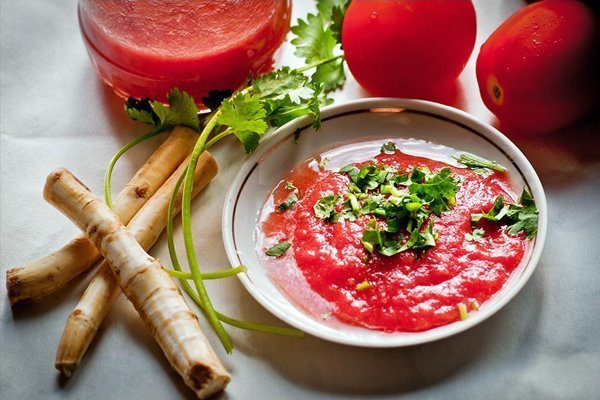 Seasoning them horseradish
Seasoning them horseradish Ingredients:
- Peeled horseradish root - 2-3 pcs;
- Fresh tomatoes - 1 kg;
- Peeled garlic cloves - 10-15 pcs;
- Sugar - 1 tbsp. l.;
- Salt to taste - 1-3 tsp.
Cooking method:
Tomatoes and horseradish rhizomes are finely chopped and passed through a meat grinder along with garlic cloves. Sugar and salt are added to the resulting mass, then thoroughly mixed until smooth. Seasoning is either immediately served to the table, or rolled up in sterilized glass jars. It is added to fried or boiled potatoes, to meat dishes, salads.
Adjika from horseradish
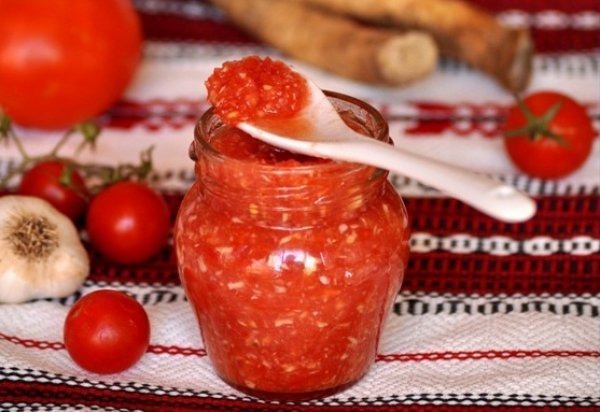 Adjika "Hrenovina"
Adjika "Hrenovina" Ingredients:
- Horseradish rhizomes - 3-4 pieces;
- Tomatoes - 2 kg;
- Onion -1 kg;
- Carrots - 1 kg;
- Sweet and sour apples -1 kg;
- Sweet pepper - 1 kg;
- Red hot pepper -3-4 pcs;
- Peeled garlic cloves - 100-120 g;
- Sunflower or olive oil - 0.5 l;
- Apple or wine vinegar - 0.5 cups;
- Table salt - 0.5 cups;
- Sugar - 1 cup.
Cooking method:
Horseradish, carrots, onions, tomatoes and apples are washed, peeled and cut into small pieces. Pepper is cleaned from seeds and also cut. All ingredients, together with garlic, are ground in a meat grinder or in a blender. The resulting mass is thoroughly mixed and put on fire. After boiling, oil is poured into the pan, sugar and salt are poured. Adjika is boiled over low heat for 60 minutes. During cooking, adjika with horseradish should be constantly stirred. Vinegar is poured 4-5 minutes before removing from heat. Immediately after cooking, adjika is rolled up in sterilized glass jars.
Contraindications
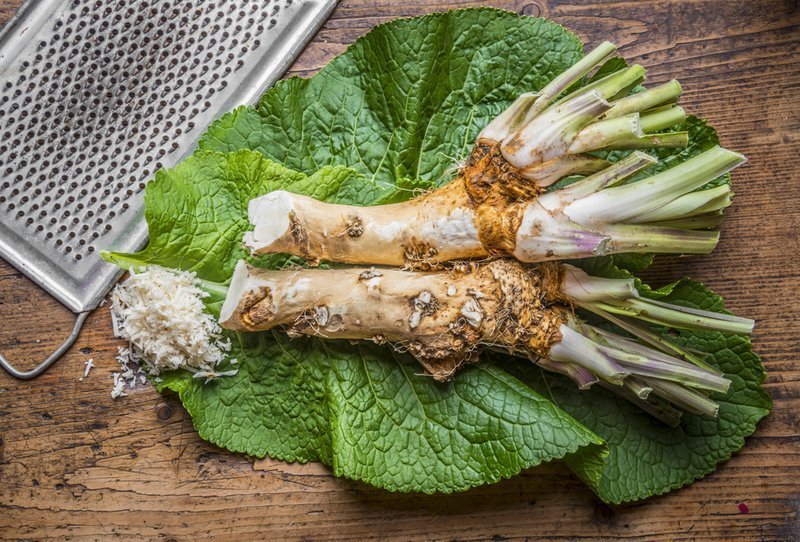
Despite the abundance of useful substances, horseradish has a number of very important contraindications. Exceeding the norm or non-compliance with the recommendations can harm the body in the form of various side effects.
Main contraindications:
- The product in any form is forbidden to be eaten with peptic ulcers of the digestive tract and kidney failure. If you are allergic to spicy food, horseradish is also excluded from the diet. This seasoning is harmful for pregnant and lactating mothers.
- Horseradish is contraindicated for children under 3 years of age. At this age, the gastric mucosa is vulnerable, and spicy food causes irreparable harm to it.
- It is forbidden to give horseradish to pregnant women and nursing mothers. In babies, it causes burns of the mucous membranes, and in pregnant women it can provoke a miscarriage.
- Excessive use of horseradish leads to intestinal upset, inflammation of the mucous membranes and problems with the respiratory system.
When to collect and how to harvest for the winter?
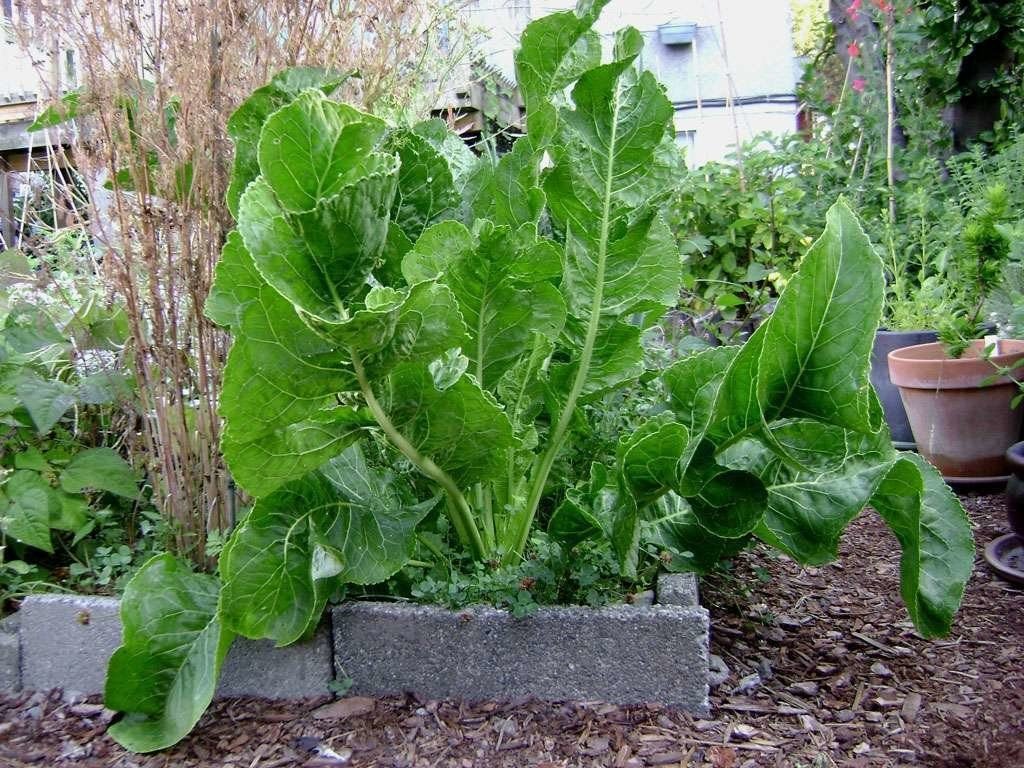
Horseradish is planted and harvested in autumn. The ideal time for landing is the end of August, the beginning of September. This culture prefers chernozem soils and peat bogs. It is collected in late October, early November, after the first frost. The leaves of the plant are recommended to be collected throughout the growing season.
Horseradish is a perennial plant and is best harvested by older roots planted 2-3 years before harvest. The collected roots are kept in a cool and dark place, under a layer of river sand or dry peat. In this form, they can lie for 5-6 months.
Harvested rhizomes should not be washed before laying for the winter. But you can store the product in powder form. The roots are chopped and dried in an oven or oven. Dried raw materials are ground and stored in a closed container, in a dry and dark place.


